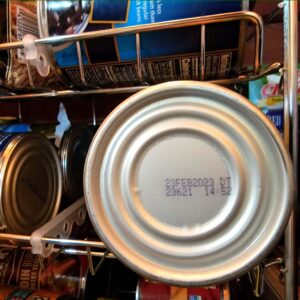
COMMON ‘USE BY’ DATES
The USDA gives these examples of the commonly used phrases that produce terror in my heart:
- A “Best if Used By/Before” date indicates when a product will be of best flavor or quality. It is not a purchase or safety date.
- A “Sell-By” date tells the store how long to display the product for sale for inventory management. It is not a safety date.
- A “Use-By” date is the last date recommended for the use of the product while at peak quality. It is not a safety date except for when used on infant formula as described below.
- A “Freeze-By” date indicates when a product should be frozen to maintain peak quality. It is not a purchase or safety date.
In fact, my husband and I are so intimidated that we sometimes check before they arrive. Now, if anything is out of date, my husband refuses to eat it.
Sigh. I remember the good old days when there were no labels. We simply sniff-tested the food. If it stunk, you threw it out. If the cheese smelled OK, but had a bit of mold on it, you just cut it off. In fact, when I was young and trying to save money, I loved nothing better than picking up meat that was on sale because it was at the expiration date. I’d slap those cheap packs into the freezer the moment I got home.
Now, at this point, two issues bother me:
- Why didn’t I die from rancid food years ago?
- How could my children adapt attitudes so different from my own?
HOW ‘USE BY’ DATES STARTED
It’s rumored that Al Capone, the notorious gangster, was one of the first people to push for food expiration dates back in the 1930s. Supposedly one of his family members got sick after drinking expired milk, spiking his interest in the industry. Subsequently he purchased a milk processor and lobbied the Chicago City Council to pass a law requiring date stamps on milk containers. It wasn’t until the 1970s that date labeling took off.
The Smithsonian Magazine had this to say regarding the history of food labeling:
The NRDC report details how consumers in the 1960s started to buy more processed foods, and as they got further away from the direct production of the ingredients in their meals, they got more worried about just how safe and fresh those ingredients were.
In response, states started mandating labeling laws, many of which we still live with today. Some have tried to get rid of the unscientific labels, but when the U.K. suggested changing the sell by labels, manufacturers weren’t pleased. There’s also speculation out there that manufacturers want you to use the dates because it means you wind up throwing out and buying more of their product.
THE TRUTH ABOUT ‘USE BY’ DATES
The USDA says:
- Federal law requires only baby formula to have product dating.
- In order to determine the date, manufacturers will consider: 1) the length of time and the temperature at which a food is held during distribution and offered for sale, 2) the characteristics of the food, 3) and the type of packaging will affect how long a product will be of optimum quality. (Translation—They guess.)
- With an exception of infant formula, if the date passes during home storage, a product should still be safe and wholesome if handled properly until the time spoilage is evident (Chill: Refrigerate Promptly). Spoiled foods will develop an off odor, flavor or texture due to naturally occurring spoilage bacteria. If a food has developed such spoilage characteristics, it should not be eaten.
- A change in the color of meat or poultry is not an indicator of spoilage (The Color of Meat and Poultry).
- The quality of perishable products may deteriorate after the date passes but the products should still be wholesome if not exhibiting signs of spoilage. Food banks, other charitable organizations, and consumers should evaluate the quality of the product prior to its distribution and consumption to determine whether there are noticeable changes in wholesomeness (Food Donation Safety Tips).
- USDA estimates that 30 percent of the food supply is lost or wasted at the retail and consumer levels.[3] One source of food waste arises from consumers or retailers throwing away wholesome food because of confusion about the meaning of dates displayed on the label.
Is Capitalism Protecting Your Health Or Is This A Scheme To Make More Money?
Let me know what you think.
P.S. Mother knows best!
Sign up on www.mariewatts.com to receive future Stories About Life delivered to your email address or read more stories by clicking here.

Recent Comments